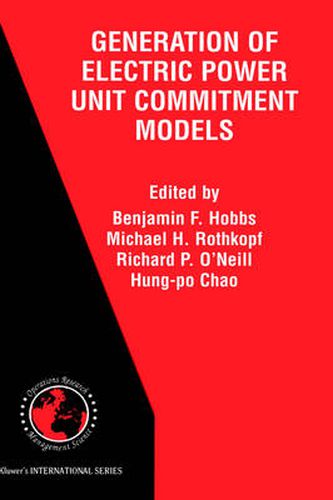Readings Newsletter
Become a Readings Member to make your shopping experience even easier.
Sign in or sign up for free!
You’re not far away from qualifying for FREE standard shipping within Australia
You’ve qualified for FREE standard shipping within Australia
The cart is loading…






This title is printed to order. This book may have been self-published. If so, we cannot guarantee the quality of the content. In the main most books will have gone through the editing process however some may not. We therefore suggest that you be aware of this before ordering this book. If in doubt check either the author or publisher’s details as we are unable to accept any returns unless they are faulty. Please contact us if you have any questions.
Over the years, the electric power industry has been using optimization methods to help them solve the unit commitment problem. The result has been savings of tens and perhaps hundreds of millions of dollars in fuel costs. Things are changing, however. Optimization technology is improving, and the industry is undergoing radical restructuring. Consequently, the role of commitment models is changing, and the value of the improved solutions that better algorithms might yield is increasing. The dual purpose of this book is to explore the technology and needs of the next generation of computer models for aiding unit commitment decisions. Because of the unit commitment problem’s size and complexity and because of the large economic benefits that could result from its improved solution, considerable attention has been devoted to algorithm development in the book. More systematic procedures based on a variety of widely researched algorithms have been proposed and tested. These techniques have included dynamic programming, branch-and-bound mixed integer programming (MIP), linear and network programming approaches, and Benders decomposition methods, among others. Recently, metaheuristic methods have been tested, such as genetic programming and simulated annealing, along with expert systems and neural networks. Because electric markets are changing rapidly, how UC models are solved and what purposes they serve need reconsideration. Hence, the book brings together people who understand the problem and people who know what improvements in algorithms are really possible. The two-fold result in The Next Generation of Electric Power Unit Commitment Models is an assessment of industry needs and new formulations and computational approaches that promise to make unit commitment models more responsive to those needs.
$9.00 standard shipping within Australia
FREE standard shipping within Australia for orders over $100.00
Express & International shipping calculated at checkout
This title is printed to order. This book may have been self-published. If so, we cannot guarantee the quality of the content. In the main most books will have gone through the editing process however some may not. We therefore suggest that you be aware of this before ordering this book. If in doubt check either the author or publisher’s details as we are unable to accept any returns unless they are faulty. Please contact us if you have any questions.
Over the years, the electric power industry has been using optimization methods to help them solve the unit commitment problem. The result has been savings of tens and perhaps hundreds of millions of dollars in fuel costs. Things are changing, however. Optimization technology is improving, and the industry is undergoing radical restructuring. Consequently, the role of commitment models is changing, and the value of the improved solutions that better algorithms might yield is increasing. The dual purpose of this book is to explore the technology and needs of the next generation of computer models for aiding unit commitment decisions. Because of the unit commitment problem’s size and complexity and because of the large economic benefits that could result from its improved solution, considerable attention has been devoted to algorithm development in the book. More systematic procedures based on a variety of widely researched algorithms have been proposed and tested. These techniques have included dynamic programming, branch-and-bound mixed integer programming (MIP), linear and network programming approaches, and Benders decomposition methods, among others. Recently, metaheuristic methods have been tested, such as genetic programming and simulated annealing, along with expert systems and neural networks. Because electric markets are changing rapidly, how UC models are solved and what purposes they serve need reconsideration. Hence, the book brings together people who understand the problem and people who know what improvements in algorithms are really possible. The two-fold result in The Next Generation of Electric Power Unit Commitment Models is an assessment of industry needs and new formulations and computational approaches that promise to make unit commitment models more responsive to those needs.